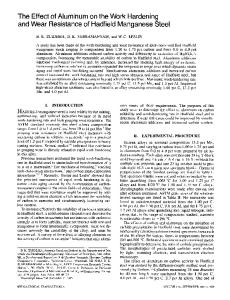Strain Hardening of Hadfield Manganese Steel
- PDF / 6,219,612 Bytes
- 13 Pages / 594 x 810 pts Page_size
- 16 Downloads / 343 Views
I.
INTRODUCTION
DESPITE extensive applications of Hadfield manganese steel since its discovery more than a century ago, ~ the mechanism of the unusual strain hardening behavior of this austenitic steel remains uncertain. Although some early investigations attributed the hardening to strain-induced a ' (bct) and e (hcp) martensites, 2'3 detailed study of the composition dependence of transformation behavior of Fe-Mn-C alloys revealed that the latter products form at lower Mn and C contents than the Hadfield composition. 4 Most recent studies associate the strain hardening with deformation twinning 5'7 invoking the effectiveness of twin boundaries as slip obstacles to provide strengthening in a manner analogous to grain refinement. 6-9 An exception is a recent analysis of the flow behavior at small strains, which suggests an important role of dynamic strain aging associated with the high carbon content.'° In view of the close similarities between deformation twinning and martensitic transformation, models developed for transformation plasticity may provide a basis for a better understanding of the influence of twinning on plastic flow behavior. Experimentally-derived constitutive flow relations" for metastable austenitic steels which deform by combined slip- and strain-induced martensitic transformation have provided a quantitative description of two important phenomena: a "dynamic softening" effect of the transformation as a parallel deformation mechanism and a "static hardening" effect of the transformation product. The interaction of the two phenomena is such that the softening effect dominates at low strains while the hardening dominates at high strains; this imparts upward curvature to the stress-strain curve in contrast to the downward curvature normally exhibited by slip-controlled plasticity. The present study was undertaken to examine the detailed stress-strain curve shape and its relation to twinning beP. H. ADLER, formerly Graduate Student at Massachusetts Institute of Technology, is with Lawrence Livermore National Laboratory, Livermore, CA 94550. G. B. OLSON, Senior Research Associate, and W. S. OWEN, Professor, are with the Department of Materials Science and Engineering, Massachusetts Institute of Technology, Cambridge, MA 02139. Manuscript submitted December 6, 1985.
METALLURGICALTRANSACTIONS A
havior during high strain deformation in both tension and compression, in order to assess the possible contributions of the various strain hardening mechanisms in Hadfield manganese steel.
II. MATERIALS AND EXPERIMENTAL PROCEDURES The composition of the commercial Hadfield steel used in this research is given in Table I. The initial grain size of the annealed and water quenched bar stock, as received, was about 50/zm. Specimen blanks, approximately 5 inches (12.7 cm) and 3 inches (7.6 cm) long, were austenitized in quartz capsules filled with argon at 1453 K (t180 °C) for 1 hour and water quenched to provide larger grains and, hence, larger twins more suitable for optical metallography. Decarburization and
Data Loading...











